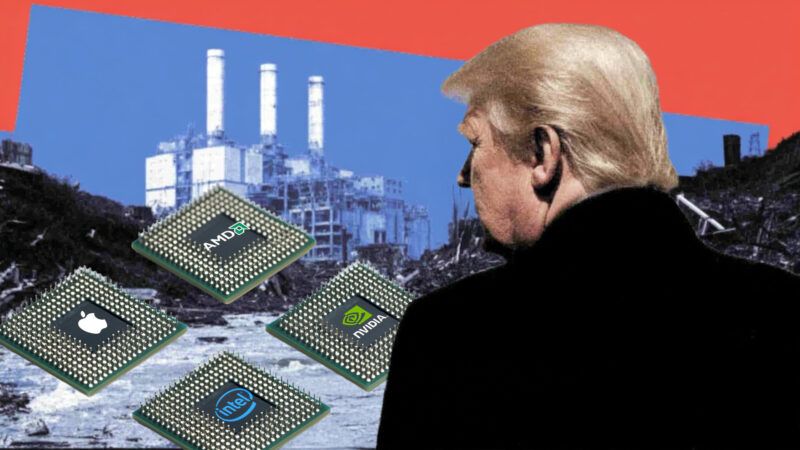Trump's 100 Percent Chip Tariff Could Make It More Expensive To Build More Semiconductors in the U.S.
Trump exempted imported chips from his reciprocal tariffs in April. Now he's threatening them with 100 percent rates.

President Donald Trump is considering imposing a 100 percent tariff on semiconductors to incentivize chipmakers to invest in domestic manufacturing, a move that would make it harder to build out American chip fabrication.
The Wall Street Journal reported on Friday that the Trump administration could soon force chipmakers "that don't maintain a 1:1 ratio [of domestic to imported chips] over time" to pay a tariff on each imported semiconductor sold to Americans beyond the number that are produced domestically. The Journal explains that, "if a company pledged to build one million chips in the U.S., it would essentially be credited with that amount over time so the company and its customers could import until its plant was completed without paying tariffs." This comports with Trump's August promise to chipmakers like Apple that "if you're building, there will be no charge."
It remains unclear just how long chipmakers would have to equalize their sales of domestic and imported chips. Likewise, the tariff rate that chipmakers would face is opaque, but Trump indicated last month that the rate could be as high as 100 percent.
Even a small rate change on chip tariffs could have huge consequences for domestic producers. The Chamber of Commerce warns that a 1 percent increase in tariffs on chips and semiconductor manufacturing equipment will increase the construction costs of all announced domestic semiconductor fabrication plants (valued at $540 billion) by as much as $3.5 billion. A 100 percent rate increase, then, could increase construction costs for these projects by $350 billion. Moreover, "additional costs will reduce demand for end market products [and] reduce investments in semiconductor R&D," diminishing American semiconductor dominance instead of enhancing it. These estimates are found in the Chamber's public comment to the Commerce Department, in response to the agency's Section 232 investigation into the national security effects of imported semiconductors, manufacturing equipment, and downstream products.
Apparently, the impending national security emergency from imported chips is not so imminent that a grace period is precluded by the proposed plan. This is fortunate for American chipmakers, as 90 percent of fabrication occurs abroad and it takes at least 38 months to build a fabrication plant in the U.S.—not accounting for "time needed to build supporting facilities and then qualify products at each fab," which adds another six months to a year, according to the Chamber.
The Commerce Department's Bureau of Industry and Security began its investigation in April and has yet to deliver its findings and recommendations in a report to Trump. In the meantime, comments strongly cautioning against semiconductor tariffs have accumulated.
Intel, "the only American company [that is] capable of producing leading-edge logic semiconductors," warned that "Section 232 tariffs could increase U.S. manufacturing costs for essential materials and components." The Semiconductor Industry Association, a trade association and lobbying group, said that "removing trade and other barriers to U.S. chips in overseas markets," which account for 70 percent of revenue to the U.S. semiconductor industry, is key to making the expansion of domestic capacity economically viable. Right now, "the complete onshoring of all semiconductor supply chain elements is not feasible, much less in a short period of time," because "supply chains have evolved over decades and cannot be rearranged overnight or even within a decade," explains the Chamber.
Trump's plan has not been officially announced and, like his reciprocal tariffs, could be delayed, changed, or reversed at the drop of a hat, making it impossible for chipmakers to rationally plan multi-billion-dollar projects. But for the time being, it appears Trump is ready to punish American chipmakers for efficiently manufacturing their products abroad and selling them to American consumers and artificial intelligence companies at competitive prices.


Show Comments (20)